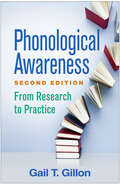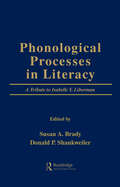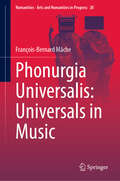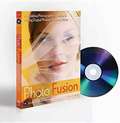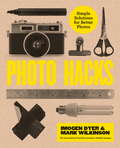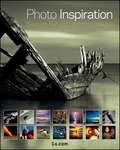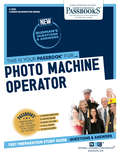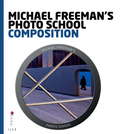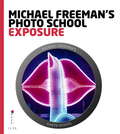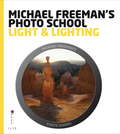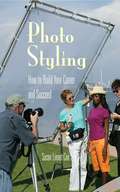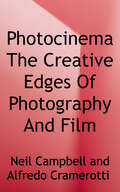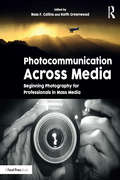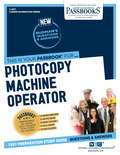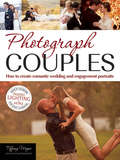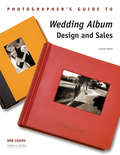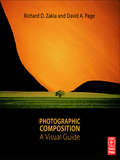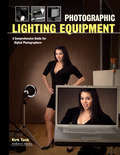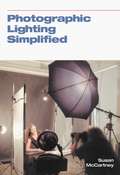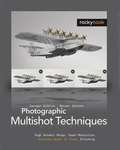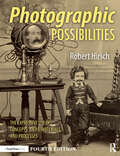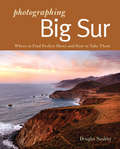- Table View
- List View
Phonological Awareness, Second Edition: From Research to Practice
by Gail T. GillonTranslating cutting-edge research into practical recommendations for assessment and instruction, this book has helped thousands of readers understand the key role of phonological awareness in the development of reading, writing, and spelling. It clearly shows how children's knowledge about the sound structure of spoken language contributes to literacy acquisition. Evidence-based strategies are described for enhancing all learners' phonological awareness and effectively supporting those who are struggling (ages 3–17). The book discusses ways to tailor instruction and intervention for a broad range of students, including English language learners (ELLs) and those with reading or language disorders. New to This Edition: *Incorporates over a decade of important advances in research, assessment, and instruction. *Chapter on ELLs, plus additional insights on ELLs woven throughout the book, including new case studies. *Chapter on spelling development. *Significantly revised coverage of children with complex communication needs.
Phonological Processes in Literacy: A Tribute to Isabelle Y. Liberman
by Susan A. Brady Donald P. ShankweilerThis impressive volume contains the edited proceedings of a symposium held in honor of Isabelle Y. Liberman, whose teaching and writings laid the foundation for contemporary views of reading disability. Her work has influenced ways of thinking about the nature of the problem and ways of working with children and adults who experience unusual difficulty in learning to read. The symposium covered four themes that were central to Dr. Liberman's research on reading acquisition and disability: the development of phonological awareness, the relationship between phonological awareness and success in learning to read and write, the investigation of other phonological processes associated with reading and writing performance, and the implications of current research on these matters for reading instruction. The text includes a paper on each topic, followed by commentaries which introduce additional research findings and theoretical considerations -- all by leading researchers in the field.
Phonurgia Universalis: Universals in Music (Numanities - Arts and Humanities in Progress #28)
by François-Bernard MâcheThis translation of Musique au singulier (2001) from the French identifies what is common to music of all times and cultures. The author, François-Bernard Mâche is a composer and internationally renowned musicologist. He addresses the question of universals in music and demonstrates how musical play is a poetic and natural game that already takes shape in the animal world. Mâche invites the reader to reconsider the traditional opposition between nature and culture and to reflect on experiencing such intense emotions when both listening to and manipulating sounds. This title appeals to students and researchers working in musicology.
Photo Fusion
by Jennifer BebbA full-color reference-and-DVD package covers shooting and editing a successful multimedia projectWith the introduction of dSLRs with high definition video functionality, a new world of multimedia capture has been opened to digital photographers. This book shows you how to embrace the exciting new option of photo fusion, by incorporating digital video content with your photography.The author duo guides you through creating seamless multimedia presentations that maximize both still-frame and video photography functions on your dSLR. From the setting up and shooting, to downloading, editing and presenting a multimedia project, this book clearly explains how to move beyond stills into the exciting world of multimedia creation.Encourages you to embrace the exciting possibilities of photo fusion in the field of wedding photographyExplains how to incorporate digital video content with photographyWalks you through all of the necessary steps for shooting and editing a memorable multimedia creationDetails every aspect involved in setting up, shooting, downloading, editing, and presenting a multimedia projectFeatures more than 200 color images and an indispensible DVD of inspiring examplesPacked with more than 200 stunning images and featuring a 45-minute DVD, Photo Fusion presents you with inspiration and instruction so you can create your own multimedia projects.Note: CD-ROM/DVD and other supplementary materials are not included as part of eBook file.
Photo Hacks: Simple Solutions for Better Photos
by Imogen Dyer Mark WilkinsonThe gear you have is good enough, and with a little ingenuity, it can be even better. Whether you're sticking to a budget or just in a creative rut, this book is packed with clever tricks and innovative techniques that will help you capture beautiful images without breaking the bank. No techie settings, no complicated plans, just awesome ideas that will quickly extend your creative toolbox. Just don't tell the guy at your camera store!
Photo Idea Index - People
by Jim KrauseRethink, revitalize and reinvent the way you shoot portraits. Photo Idea Index: People is a photography book unlike any other. Rather than focusing on the "how to" aspects of digital photography, author Jim Krause focuses on the "what if" aspects. You'll learn how to use your camera to photograph people around you from different perspectives and how to capture personal, beautiful digital images. You'll learn how subtle variations in setting, lighting, props and digital manipulation can change the look of an image dramatically. Krause shares his shooting techniques-both on-site and post-shooting digital treatments-so you can train your eyes to look for situations that will allow you to capture unique shots and create remarkable compositions.
Photo Idea Index - People: Ideas and Inspiration for Creating Professional-Quality Images Using Standard Digital Equipment
by Jim KrauseRethink, revitalize and reinvent the way you shoot portraits.Photo Idea Index: People is a photography book unlike any other. Rather than focusing on the "how to" aspects of digital photography, author Jim Krause focuses on the "what if" aspects. You'll learn how to use your camera to photograph people around you from different perspectives and how to capture personal, beautiful digital images. You'll learn how subtle variations in setting, lighting, props and digital manipulation can change the look of an image dramatically.Krause shares his shooting techniques-both on-site and post-shooting digital treatments-so you can train your eyes to look for situations that will allow you to capture unique shots and create remarkable compositions.
Photo Inspiration
by 1x. ComThe inspiration you need to help improve your photography skillsWell-known for their stunning world-class photography, 1x.com has worked with their most talented photographers to handpick 100 awe-inspiring images and provided the back-story and photographer's secrets that helped capture them. This book presents you with inspiration as well as underlying techniques that can help improve your photography skills immediately.Shares behind-the-scene stories of the featured photos from the photographers themselves, from their artistic vision to the technical details that went into each shotOffers clear, concise, and accessible descriptions for the ideas, vision, performance, setup, location, equipment, camera settings, lighting diagrams, and image editing methods of each amazing photoPhoto Inspiration provides a unique combination of the final photograph with the tools and knowledge that made it possible, all of which are aimed at helping you meet your photographic potential.
Photo Machine Operator: Passbooks Study Guide (Career Examination Series)
by National Learning CorporationThe Photo Machine Operator Passbook® prepares you for your test by allowing you to take practice exams in the subjects you need to study. It provides hundreds of questions and answers in the areas that will likely be covered on your upcoming exam.
Photo Op: 52 Weekly Ideas for Creative Image-Making
by Kevin MeredithFirst published in 2010. Routledge is an imprint of Taylor & Francis, an informa company.
Photo School Composition: Composition (Michael Freeman's Photo School Ser.)
by Michael Freeman Daniela BowkerIn this title, Michael Freeman and Daniela Bowker teaches how to use a photographic eye to not only seek out engaging subjects, but also approach them from the best angle, in optimal light, for the maximum effect.
Photo School Exposure: Exposure: Essential Aspects Of Exposure
by Jeff Wignall Michael FreemanA thorough understaNding of exposure is the foundation of every photographer's education. This book introduces these concepts in a comprehensive and interactive format. Casting aside auto mode, readers will learn to take creative control of their photographs as they master the essential elements of aperture, shutter speed and ISO.
Photo School Light & Lighting: Light And Lighting (Michael Freeman's Photo School Ser.)
by Michael Freeman Catherine QuinnLearn to read light in this complete course on the most important aspect of every photograph. Beginning with an overview of how digital cameras measure and record light, Michael Freeman goes on to explore the different ways to interact with existing light.
Photo Styling: How to Build Your Career and Succeed (Starting Your Career Ser.)
by Susan Linnet CoxDefinitive book on starting a career in photo styling Essential information plus business forms and insider tips Editorial, wardrobe, food styling-every specialty is covered. In real life, nothing looks as good as it does in magazines and on television. Who makes that happen? Photo stylists, that's who! Here's the definitive book on starting a career in photo styling, from choosing a specialty in editorial, wardrobe, soft goods, room sets, food styling, or another area, to working with the photo crew. Readers will learn how to create a portfolio, network, and market themselves, and interviews with real working stylists are packed with great advice and anecdotes. Business forms for proposals, job sheets, and invoices, plus top-secret tips like merchandise returns and retagging garments make Photo Styling the one-stop shop for everything the budding stylist needs.
Photocinema: The Creative Edges of Photography and Film (Critical Photography Series)
by Neil Campbell Alfredo CramerottiTaking as its starting point the notion of photocinema--or the interplay of the still and moving image--the photographs, interviews, and critical essays in this volume explore the ways in which the two media converge and diverge, expanding the boundaries of each in interesting and unexpected ways. <p><p>The book's innovative approach to film and photography produces what might be termed a hybrid "third space," where the whole becomes much more than the sum of its individual parts, encouraging viewers to expand their perceptions to begin to understand the bigger picture. <p><p>The latest edition in Intellect's Critical Photography series, Photocinema represents a nuanced theoretical and practical exploration of the experimental cinematic techniques exemplified by artists like Wim Wenders and Hollis Frampton. In addition to new critical essays by Victor Burgin and David Campany, the book includes interviews with Martin Parr, Hannah Starkey, and Aaron Schumann, and a portfolio of photographs from various new and established artists.
Photocommunication Across Media: Beginning Photography for Professionals in Mass Media
by Ross Collins Keith GreenwoodPhotocommunication Across Media is a must-have for aspiring mass media professionals who are striving to compete in the new landscape of convergence journalism and media. You will learn principles of photography both still and video and how to incorporate them into your storytelling. That’s no longer a specialty skill—in today’s world of media, it’s a necessity. Editors Ross Collins and Keith Greenwood collaborate with highly accomplished photographers to make the concepts and techniques of today’s mass media photography accessible to all readers. Photocommunication Across Media speaks directly to journalists, advertisers and professional communicators who want to round out their toolkit without sifting through dense texts meant specifically for photographers and photojournalists. This guide, edited by experts who teach these concepts to the next generation of media professionals, is everything you need to know—and nothing you don’t—to take the next step for your career in communication.
Photocopy Machine Operator: Passbooks Study Guide (Career Examination Series)
by National Learning CorporationThe Photocopy Machine Operator Passbook® prepares you for your test by allowing you to take practice exams in the subjects you need to study. It provides hundreds of questions and answers in the areas that will likely be covered on your upcoming exam, including but not limited to: understanding and interpreting written material; arithmetic computations; record keeping and compiling information; clerical operations; and more.
Photograph Couples
by Tiffany WayneWedding and portrait photography is a vast segment of the professional portrait industry. Those who cater to this demographic know that photographing couples during a very exciting period in their lives demands a unique skill-set-these sessions are done when emotions are high, in a wide range of locations, and under a staggering array of conditions. Still, the photographer must wrangle all of the variables to create images that flatter the subjects AND tell the story of their relationship.In this book, Tiffany Wayne presents 60 high-caliber images-each paired with gorgeous alternate poses-and detailed text showing readers how each image was conceived and orchestrated to flatter the couple and show their unique relationship to best effect. In 60 two-page spreads, readers will get a behind-the-scenes look at how the image came together. Wayne discusses her intent for each image, then shows the steps used to carry out her artistic vision-from positioning the individual subjects, to creating a physical bond, and eliciting emotion. Also detailed are the compositional choices that were made to reinforce and strengthen the portrait presentation.In the first part of the book, Wayne showcases engagement portraits-images made under more relaxed conditions when the pace of the day is not as hectic as it will be on the wedding day. In the second part of the book, Wayne turns her attention to wedding portraits of the couple.With the fresh, modern feel of Tiffany Wayne's images and her casual, seemingly effortless-yet perfect-posing approach, readers will find much to emulate in this book.
Photographer's Guide to Wedding Album Design and Sales
by Bob CoatesFull of instructive images and insightful hints, this book is indispensable for photographers who want to boost their wedding-album sales. Updated with the latest styles, this showcase of 15 top wedding photographers' work and business practices provides insight into each artist's creative process, client service skills, and album design. Information on album types and basic design principles is accompanied by tips for marketing albums, including creating a dazzling sample album, expertly preparing the images for presentation after the ceremony, and discussing the importance of the album as a memento to be cherished for a lifetime. Savvy photographers will learn how to turn an album purchase into a multiple-album sale, how to add on á la carte images, and how to make networking and referrals generate additional business.
Photographic Composition: A Visual Guide
by Richard D. Zakia David Page"Those of you who follow this blog know that Dr. Richard Zakia, former RIT professor, is one of my all time favorite photo gurus. We send each other pictures. We talk about looking into pictures - and not just looking at them. Big difference.. Dr. Richard Zakia, a.k.a. Dick, is the co-author, along with David Page, of Photographic Composition: A Visual Guide. These two dudes are also two of my favorite people."---Rick Sammon's blog "Covers all the tips needed to help photographers construct their own unique, outstanding images and is an outstanding 'must' for any collection."--CA Bookwatch
Photographic Lighting Equipment
by Kirk TuckFrom flashlights and top-of-the-line studio electronic flashes to light stands and battery/inverter packs, this all-encompassing survey evaluates the vast array of lighting and equipment options available to professional photographers. Beginning with a basic history of the role of lighting equipment and the interplay between advances in capture and lighting technologies, the emphasis then shifts to advances made within the past five years that have enabled photographers to consider more low-powered and cost effective options than ever before. In addition to identifying the wide range of gear currently on the market#151;as well as those photographers may devise on their own#151;this reference examines the pros and cons of the various technologies and provides suggestions for their most practical use. Photographs of the equipment surveyed as well as real-life images created with the different pieces of equipment are interspersed throughout the text. Other helpful hints include tips for maximizing versatility, investment in each piece of equipment, and a #147;Top-Ten Must-Have List. ”
Photographic Lighting Simplified
by Susan MccartneyFor aspiring photographers ready to transform their work from average to expert, here is the "bible" to lighting any subject and space effectively. In specific but nontechnical terms, Photographic Lighting Simplified explains how to take light sources-from outdoor bright sunlight to indoor household lighting-and recreate their effects in the studio. A series of enjoyable, hands-on assignments show readers tips for selecting the right camera format, film, and lenses; the basics of metering and testing; overviews of essential equipment for studio lighting; and much more. Plus, dozens of step-by-step illustrations demonstrate an array of techniques for lighting reflective metal and glass objects; lighting different face types and groups; and special lighting considerations for digital cameras. For anyone who is serious about taking better photographs, this is the ultimate success guide.
Photographic Multishot Techniques
by Juergen Gulbins Rainer GulbinsPhotographers are just beginning to realize the potential of high dynamic range imaging (HDRI). Now, the newest techniques based on a bracketed series of exposures make it possible to go beyond HDRI: photographers can increase resolution for ultra-sharp, detailed images, and they can extend the depth of field in a way that was never before possible. Photographic Multishot Techniques provides a thorough introduction and is a hands-on guide to these various techniques. Using a series of example images, the authors explain and illustrate the use of each technique. Included are lessons on HDRI, super-resolution, focus stacking, and stitching images. Moreover, the reader will learn how to effectively combine these various techniques to create amazing images. Throughout the book, the authors use tools such as Photoshop, PhotoAcute, Photomatix Pro, FDRTools, CombineZM, DOP Detail Extractor, and Helicon Focus to illustrate the workflow with detailed, step-by-step instructions. Most of these tools offer free trial versions that are available for download at the Rocky Nook Website at the book description of "Photographic Multishot Techniques". Learning to use these cutting-edge techniques is sure to expand the repertoire and improve the photographic skills of the professional, as well as the advanced amateur, photographer.
Photographic Possibilities: The Expressive Use of Concepts, Ideas, Materials, and Processes
by Robert HirschThe long-awaited new edition of this seminal text features clear, reliable, step-by-step instructions on innovative alternative and traditional photographic processes. Over and above a full update and revision of the technical data, there are new sections on digital negative making, electrophotography, and self-publishing. Foremost practioners, including Edward Bateman, Dan Burkholder, Tom Carpenter, Mark Osterman, France Scully Osterman, Jill Skupin Burkholder, Brian Taylor, and Laurie Tümer, have contributed their expertise to this edition. Perfect for practitioners or students of handmade photography, the book covers classic black-and-white film and paper processes, hand-coated processes like Cyanotype, and Platinum/Palladium. Also featured is an enhanced section on gum bichromate, invaluable instruction on workflow, and the integration of digital, promoting the effective union of one’s concepts, materials, and processes. The book showcases work and commentary from more than 150 international artists.
Photographing Big Sur: Where to Find Perfect Shots and How to Take Them
by Douglas SteakleyAn exciting series that combines wanderlust with the art of photography. The rugged Big Sur coastline is one of the most photogenic in the world. Th e route along Highway 1 dips down to pristine beaches and climbs precariously high above the Pacific, offering sweeping panoramic views. There is also a great variety of wildlife, including gray whales, porpoises, sea lions, and elephant seals. Patient and lucky photographers might also spot endangered California condors riding the thermals. This book describes the best photo locations for novices and professionals alike, beginning with Point Lobos and continuing south to Hearst Castle and San Simeon. Clear directions and detailed maps are here too. Professional photographer Doug Steakley guides you to the right place at the right time of day to get memorable photographs.
